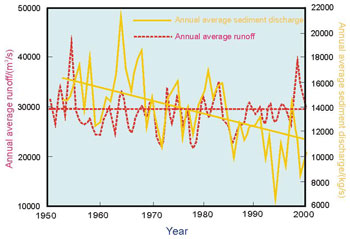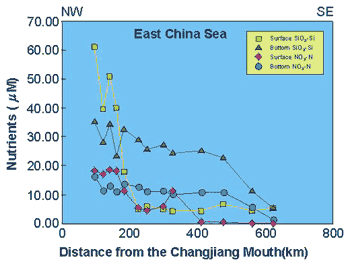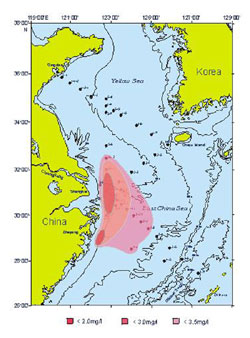|
Present State and Tendency of ECS Pollution
Sediments
Although large-scale ocean processes influence ECS greatly, the large water discharge and sediment loads from rivers play important role in physical processes, morphologic development, and ecosystem health of the continental shelf of ECS. As known as well, keeping a certain extent of water discharge and sediment loads is a basis of ECS ecosystem stability, therefore the long term changes of discharge volume and material flux into ECS, specially from the Yangtze River.
At present, annual average runoff and sediment discharge at Datong Station in the lower Yangtze River are 29,300 m3s-1 and 10,700 kg s-1 respectively (Fig.5). There are 48,000 reservoirs constructed in the Yangtze River drainage basin over last 50 years (Fig.3), in which 965 reservoirs are middle and large scale, and also there are innumerable water transfer engineering. Although retaining water by reservoirs only regulate water volume timely and have no significant influence on runoff volume, sediment discharge flux into the sea are largely affected, especially particulate state nutrients. The variations of annual average runoff and sediment discharge at Datong St. over last 50 yeas show that both have period fluctuate, but annual average sediment discharge presents very decreased trend while annual average runoff has no obvious change trend. Therefore, material discharge flux, including organic particles and particulate state nutrient fluxes and so on, must have same decreasing trend. Probably, that has close relation with dam constructions and water transfers in the Yangtze drainage basin.
| (拡大画面:56KB) |
 |
Fig. 5 |
Variations of annual average runoff and sediment discharge at Datong Station in the lower |
Persistent Organic Pollutants
According to the monitoring data of variations of BHC and DDT contents in the surface sediments of the Yangtze River estuary since the last decades as well as the vertical changes of BHC and DDT contents in sedimentary cores dated by 210Pb, it is indicated that BHC and DDT contents have decreased rapidly since the use of organochlorinated pesticides was forbided by China government in 1983 (Tab.1). Although these high remainder pesticides can affect marine environment and marine organism continuously for decades, the concentrations of organochlorinated pesticides in ECS are not high, lower than the SWQS.
Tab. 1 |
Variations of BHC and DDT contents in surface sediments in the Yangtze Estuary since 80s (ng/g) |
| Time |
BHC |
DDT |
| Aug. 1981 |
3.26 |
12.38 |
| Jan. 1992 |
− |
0.94 |
| Oct. 1997 |
0.38 |
0.17 |
|
Sewage
Total 10.02 billion tons of industry sewage from 11 provinces along the coasts of China was drawn off in 1999, in which 3.67 billion tons directly discharged into sea. The sewage quantities into four great sea regions were 0.56 billion tons in Bohai, 0.71 billion tons in the Yellow Sea, 1.48 billion tons in ECS and 0.92 billion tons in the South China Sea respectively. The ECS occupied 40.3% of total industry sewage and became the largest industry sewage load sea region in China.
At same year, living sewage from 11 provinces along the coasts of China was 10.81 billion tons, directly discharged into the sea was 3.95 billion tons, in which 40.3% discharged into ECS. Therefore, ECS also was the largest living sewage load sea region in China.
Besides, there are 25 oil/gas wells running in China jurisdictional sea regions in 2000, annual discharge oil-contained sewage was 4.648 million tons, in which ECS with 1 oil/gas well only discharged 300,000 tons (Tab.2). Oil pollution in ECS mostly focuses on the Yangtze River estuary, Hangzhou Bay and Zhoushan Fishing Ground, where oil contents exceeded the Fishery Water Quality Standard. Recently increasing trend of oil pollution appears in ECS.
Tab. 2 |
Statistics of distribution and sewage discharge of oil/gas wells of China in 2000 |
| Sea Regions |
Oil/Gas Wells |
Oil Sewage Discharge
(x104tons) |
Oil Discharge
(x104tons) |
| Bohai |
8 |
246 |
54 |
| ECS |
1 |
30 |
5 |
| SCS |
16 |
4372 |
1302 |
| Total |
25 |
4648 |
1358 |
|
As main land based sewage source into ECS, the Yangtze River basin catches 42% of total sewage discharge of 15 billion tons of China, in which industry sewage was 11.42 billion tons and living sewages was 3.8 billion tons, occupied 45% and 35.7% of total industry and living sewages of China respectively. Annual sewage discharge of 21 cities along the main stream of the Yangtze River basin was 6.3 billion tons, and increasing in speed of 3.3%, among them 70% did not fitted the national discharge standard. Polluted length of river reaches of these cities exceeded 500 km, occupying more than 60% of the cities river reaches. Eventually, most of sewage is discharged into ECS through the Yangtze River estuary.
Nutrients
Nutrient pollution is one of main characteristics of the Yangtze River estuary and its adjacent ECS, which causes eutrophication of coastal ocean and estuarine area and very often stimulate red tide occurring. In recent two decade, nutrient pollution in the Yangtze River estuary and its adjacent ECS became much heavy year after year and polluted areas expand continuously duo to fertilizer use increasing started in 80s (Fig.6). Average content of inorganic nitrogen in the Yangtze estuary and its adjacent sea was worse than the Class I of SWQS in 1985, but only by 1991 inorganic content-exceeding standard was 9 times. The highest content-exceeding standard reached 14 times while large sea area was polluted in 1994. For phosphorus pollution in ECS inorganic phosphorus concentration had exceeded the SWQS early in 1985. Compared with other sea regions in China, ECS is the heaviest polluted one. From the monitoring data of N and P in ECS in 2000, polluted extent of ECS can be estimated to reach almost about 200 km far from east coast of China (Fig.7).
Duo to eutrophication frequently causes a yearly harmful
algae bloom, it also gives a heavy stress on the Yangtze River estuaries and the
environment of ECS. Large amounts of nutrients from the river basin area and from
the atmosphere lead to the enhanced primary production and particulate organic
matter production in the estuaries, and to serve hypoxia (dissolved oxygen <2mg
1-1) in bottom water. A large extent of hypoxic water
found in bottom off the Yangtze River in the East China Sea in summer demonstrates
that oversupply of nutrients from the Yangtze River is enhancing the eutrophic
character of the Yangtze Estuary and adjacent marine environment of ECS (Fig.8).
Fig. 6 |
Historical variations of nitrate concentrations at Datong station |
| (拡大画面:28KB) |
 |
Fig. 7 |
Changes of nutrient concentrations in ECS |
| (拡大画面:113KB) |
 |
Fig. 8 |
Estimated hypoxic area in ECS |
Solid Waste
Total volume of solid waste dumped into ECS was 36.44 million m3 in 2001, which was constituted by dredging mud from harbors, inland rivers and navigation channels. Duo to limitation of hydrodynamic conditions, seasonal variations of dumping volumes are very large Generally, on the dry season there are relatively more dumping volumes. The ratios of dumping volumes occupying the total dumping volumes of ECS were 73.2% in the sea region of Shanghai, 9.5% in the sea region of Lianyungang, Jiangsu, 16.1% in the sea region of Zhejiang and 0.3% in the sea region of Fujian. Dredge materials dumped into ECS mainly belong to the Class III dredging materials according to the Dredging Dumping Quality Standard. Main compositions of these dredging materials were Cu and its compounds, Pb and its compounds, Zn and its compounds, As and its compounds, Cd, Cr, organic maters, sulfide, PCBs, DDT, BHC, oil hydrocarbons and so on, in which Cu, Pb, Zn, Cd, Ag and oil hydrocarbons contents occasional exceed the standard, others are not very high. The dredging mud mostly polluted by land pollutants. Along with increasing of dredging engineering, amounts of dumping into ocean will be increasing greatly in the future.

Imaging: |
Imaging: Sandstorm occurred in China on April 16 1998 |
Sandstorms are strong windstorms, especially in semi-arid areas neighboring deserts, which carry clouds of sand or dust, usually causing serious air pollution (see imaging). Sand dust also is another pollution from land solid matter source and may contain some contaminants that can be transported into the ocean from atmosphere. China has been frequently attacked by sandstorms raging across the country's northern regions, particularly the drought-prone Northwest in recent years. World climate changes and the droughts in China over the past years are major reasons for more sandstorms. At the same time, spreading desertification caused by overlogging or overgrazing, the random-use of water resources and large-scale construction projects for rapid urbanization have also resulted in bad weather. Statistics from the China Meteorological Administration indicate that by mid-May this year, sandstorms have appeared 18 times, blowing sand or dust in the North, Northwest, and parts of Northeast China, and even across Japan Sea and Northern Pacific Ocean to reach North America. To tackle the problem, a series of effective counter-measures, including massive afforestation throughout China and turning lots of farmland into forests or grassland in western regions can help reduce the damage caused by sand or dust storms in the coming years.
Effects of the TGD and Water Transfer in the Yangtze River Basin
Maintaining and extent of discharge volume and material flux into the ECS on dry and flood seasons is a basis of keeping ECS ecosystem stability and environmental heath. If inappropriate large-scale water transfer and dam constructions in the Yangtze River basin will change this basis. Water transfer will affect discharge volume and dam constructions will influence not only discharge volume but also material flux. Since precipitation distribution and quantities each year are not uniform in different regions of the Yangtze River basin, material sources are different in different regions. Therefore, water transfer without affecting long-term rhythm variations of material loads and organism life cycles are very limited, as well as the selecting water transfer time and amounts. Moreover, log term effects of future population growth pressure and global climate change on demands of water resources in the lower reaches of the Yangtze River also are not considered sufficiently. It is suspectable how much runoff goes into the ECS after water transfer in dry season.
Countermeasure of Preventing East China Sea Pollution
To prevent ECS pollution and protect ECS environment, following countermeasures are needed to do now:
1. Regulating the industry structures along the coasts of ECS and in the Yangtze River Drainage Basin and focusing on developing high technological industries.
2. Increasing investment for pollution treatment, limiting economic scale and carrying out pollutant total control.
3. Studying population carrying capacity of coastal areas and the Yangtze River Drainage Basin and limiting population growth.
4. Reinforcing security of the ocean and stopping marine contaminating events occurring.
5. Promoting cooperation with developed countries in the field of ocean environmental protection.
References:
[1] Chen Jianfang, Ye Xinrong, et al.1999. Preliminary study on the marine organic pollution history in Changjiang Estuary-Hangzhou Bay-BHC and DDT stratigraphical records China Environmental Science. 19(3),p.206-210.
[2] Li Daoji, Zhang Jing et al. 2002. Oxygen depletion in the Changjiang (Yangtze) estuary. Science in China (Series D), Vol.32, No.8, p.686-694
[3] Report of China Marine Environmental Quality, 1999,2000,2001. Issued by the State Oceanic Administration, P.R. China.
[4] Report of China Environmental Quality, 1989, 1990, 1991, 1992, 1993, 1994, 1995, 1996, 1997, 1998, 1999, 2000, 2001. Issued by the State Environmental Protection Administration, P.R. China.
|